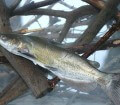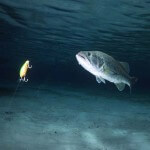John’s Note: When you think of freshwater fish, anything over 10 pounds usually is considered big – very big. But, there are five real giants, topping or approaching the 100-pound mark, that lurk in the depths of America’s freshwater lakes and rivers. Here’s what they are, where they live, and how you can do battle with them.
One night there was no wind. The full moon and the fire from the camp illuminated the cabin cruiser as it sat in the peaceful lagoon. In the background, the music built as the camera panned down on the inky blackness. A giant creature came up from the murky bottom; it was heavily scaled and looked every bit the part of a prehistoric monster. When this creature from the Black Lagoon appeared, it immediately struck horror in my heart and the hearts of all the other children who viewed the movie.
After seeing the movie, “The Creature from the Black Lagoon,” I visualized the monster swimming off with my fishing line and carving its way to its underwater kingdom with its hands, as he fled the pressure of my pole each time my rod bowed, and my drag squealed. Most of the time, I hoped that the monster or whatever it was would escape before I could bring it to the boat. This was always true when I was night-fishing for cats, because that was the time that monsters stalked.
 Prehistoric creatures and freshwater monsters are only figments of some Hollywood scriptwriter’s wild and vivid imagination, or are they? Do these monsters still exist? Could there be some refugees, from a time before history, lying close to the bottom of U.S. swamps, ponds, lakes and rivers, swimming slowly and sluggishly? Could there be demons and dragons and not just in a Dungeons and Dragons game?
Prehistoric creatures and freshwater monsters are only figments of some Hollywood scriptwriter’s wild and vivid imagination, or are they? Do these monsters still exist? Could there be some refugees, from a time before history, lying close to the bottom of U.S. swamps, ponds, lakes and rivers, swimming slowly and sluggishly? Could there be demons and dragons and not just in a Dungeons and Dragons game?
Even in Biblical times, the leviathan, an animal that must have lived both in the water and on the land, was mentioned. In Job, Chapter 41, the Bible tells about the uselessness of trying to catch him with fishhooks (verse 1) or with harpoons (verse 7), and says he made the deep water boil like a pot with his commotion (verse 31). Job 41, verses 18 to 21, states, “When he sneezes, he gives out a flash of light. His eyes are like the rays of the dawn. Out of his mouth shoot flames – from him fly sparks of fire. Out of his nostrils come smoke like a pot heated over brushwood. His breath sets coals on fire, and a flame pours from his mouth.” (American Translation-Beck) Could any of those monsters of Bible days have survived until today? And even today, there is an animal that snorts fire, the tiny bombardier beetle, which is only 1/2-inch long.
There are freshwater fish weighing more than 100 pounds waiting to take your line in the rivers, streams and lakes near your home. True, they probably will not swallow your boat or leap from the water and drag you under. But, they are there, and they are catchable.
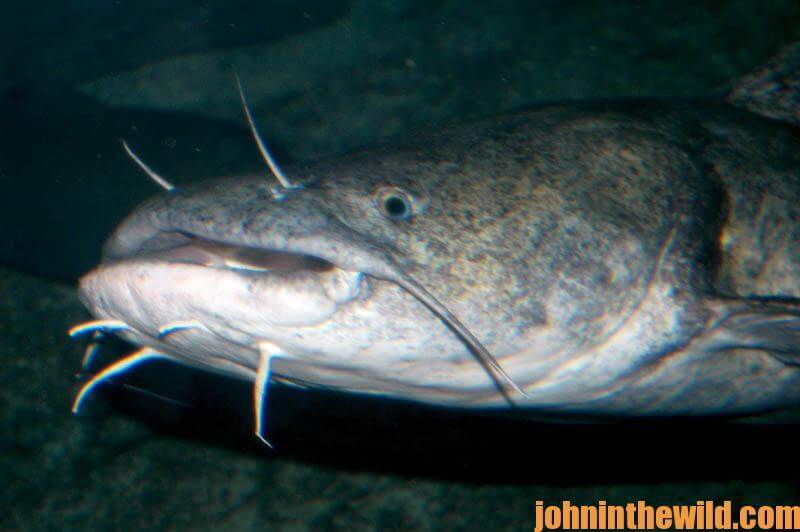 If you want to try for freshwater fish weighing around 100+ pounds, consider angling for the flathead and the blue catfish. Paddlefish also have been weighed in at more than 200 pounds, while alligator gar have been recorded at 300-pounds plus, and the sturgeon at more than 400 pounds. All five of these freshwater monsters are considered excellent sportfish.
If you want to try for freshwater fish weighing around 100+ pounds, consider angling for the flathead and the blue catfish. Paddlefish also have been weighed in at more than 200 pounds, while alligator gar have been recorded at 300-pounds plus, and the sturgeon at more than 400 pounds. All five of these freshwater monsters are considered excellent sportfish.
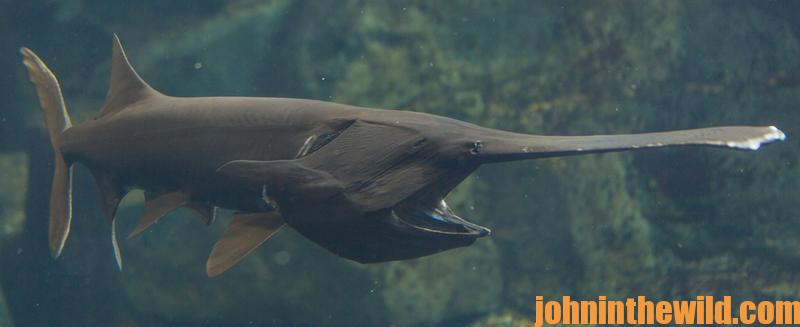 These fish prefer different types of habitat. The paddlefish, also known as the spoonbill cat, likes rivers and lakes with extensive stream gravel beds; while the flathead cat prefers long, deep, slow-moving pools of large rivers with hard bottoms. The blue catfish favors clear, swift streams; the gar likes the shallows of backwater sloughs, oxbow lakes, and bayous; and sturgeons inhabit most of the oceans and freshwater rivers in the Northern Hemisphere.
These fish prefer different types of habitat. The paddlefish, also known as the spoonbill cat, likes rivers and lakes with extensive stream gravel beds; while the flathead cat prefers long, deep, slow-moving pools of large rivers with hard bottoms. The blue catfish favors clear, swift streams; the gar likes the shallows of backwater sloughs, oxbow lakes, and bayous; and sturgeons inhabit most of the oceans and freshwater rivers in the Northern Hemisphere.
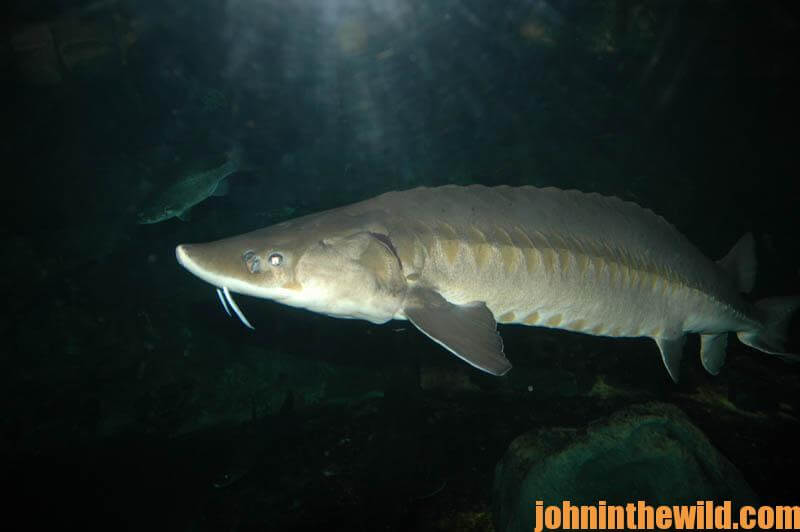 The record of the existence of three of these freshwater monster fishes can be found written in the history of this planet. The sturgeon, which today lives to be more than 75-years old, and the alligator gar are considered primitive fish with the alligator gar dating back to the Mesozoic Era. The American paddlefish, with a lifespan of up to 30 years, and its only living close relative, the endangered Chinese paddlefish, which is found in China’s Yangtze River, are part of a group of fossil fishes. Although 9/10 of all fish have bony skeletal systems, the paddlefish and the sturgeon have a cartilaginous skeleton like that of a shark. The alligator gar and the sturgeon have a platelike armor, while the catfishes and the paddlefish are scaleless.
The record of the existence of three of these freshwater monster fishes can be found written in the history of this planet. The sturgeon, which today lives to be more than 75-years old, and the alligator gar are considered primitive fish with the alligator gar dating back to the Mesozoic Era. The American paddlefish, with a lifespan of up to 30 years, and its only living close relative, the endangered Chinese paddlefish, which is found in China’s Yangtze River, are part of a group of fossil fishes. Although 9/10 of all fish have bony skeletal systems, the paddlefish and the sturgeon have a cartilaginous skeleton like that of a shark. The alligator gar and the sturgeon have a platelike armor, while the catfishes and the paddlefish are scaleless.
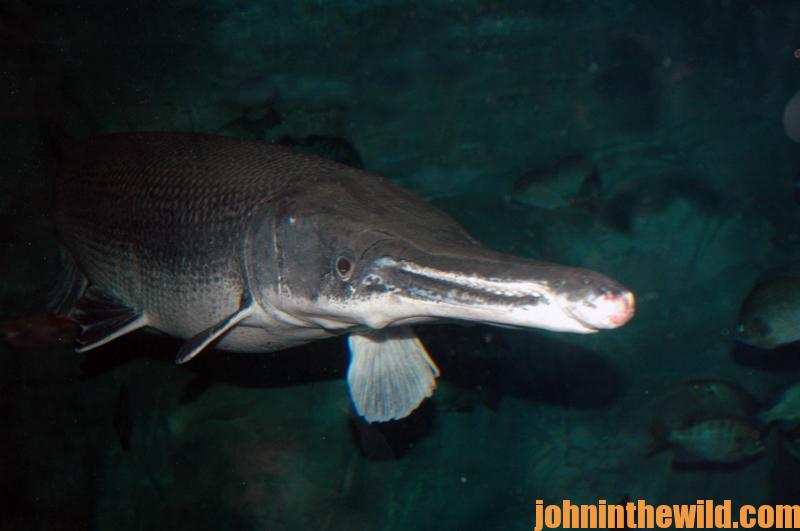 Some of these freshwater monsters leave their huge mouths open to catch unsuspecting plankton and insect larvae (the paddlefish) and fish (the flathead catfish). The catfish and the sturgeon have barbels around their mouths that they use as feeders to help them home in on vibrations and food scents. All of the fish are high in food value with the roe of the paddlefish and the sturgeon being very delicious. The sturgeon (except for the green sturgeon) is also a good protein source. Everyone is familiar with the catfish’s white, flaky meat. And in many areas of Louisiana, alligator gar is considered a delicacy.
Some of these freshwater monsters leave their huge mouths open to catch unsuspecting plankton and insect larvae (the paddlefish) and fish (the flathead catfish). The catfish and the sturgeon have barbels around their mouths that they use as feeders to help them home in on vibrations and food scents. All of the fish are high in food value with the roe of the paddlefish and the sturgeon being very delicious. The sturgeon (except for the green sturgeon) is also a good protein source. Everyone is familiar with the catfish’s white, flaky meat. And in many areas of Louisiana, alligator gar is considered a delicacy.
To learn more about fishing, you can get John E. Phillips’ eBooks and print books at www.amazon.com/author/johnephillips or at www.barnesandnoble.com.

